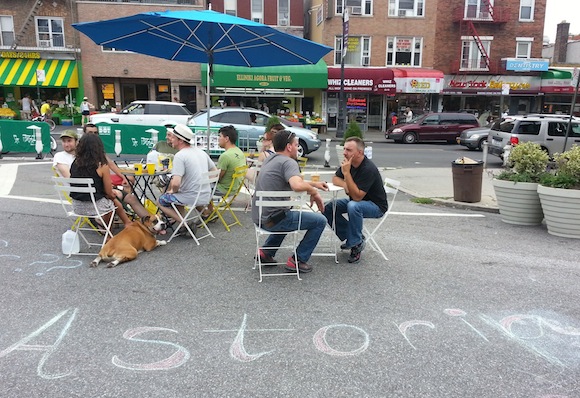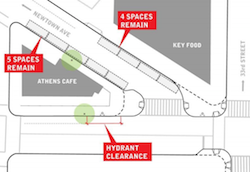
DOT went before Queens Community Board 1 on Tuesday to propose a pedestrian plaza at the intersection of 30th Avenue, 33rd Street and Newtown Avenue. The audience at the meeting was split on the proposal, but CB members were not: They voted against the plaza 25 to 7.
Since the board rejected the plaza, which would have cost $75,000 to install, the location will be receiving three smaller, but permanent, curb extensions at a cost of $400,000. The project could begin as soon as spring 2013. Legally, community boards serve only an advisory role, but DOT representatives said at the start of the meeting that the agency would not install the plaza if the community board voted against it.
Plaza supporters had formed Friends of Newtown Plaza to advocate for a community board "yes" vote, but the plaza was opposed by Council Member Peter Vallone Jr., who favored a smaller intervention that would have preserved through traffic (which DOT had previously rejected). Local business interests, including the 30th Avenue Business Association, were also vocal in their opposition.
Newtown Plaza was the site of DOT's first one-day demonstration plaza on the last Saturday in August. At the event, DOT staff surveyed passersby about their preferences for the location. Support for the plaza was overwhelming, with 96 percent saying they would like a permanent plaza. And the vast majority -- 88 percent -- said they got to the plaza by walking. Most respondents came from the immediate neighborhood or adjacent zip codes and cited safety, cleanliness and public space as their top priorities. Few respondents identified parking as a priority.
A plaza would also have helped address the lack of public space in Astoria. According to DOT, city guidelines call for a minimum of 65 square feet of open space per person. Queens has 206 square feet per person, while Astoria has only 16 square feet per person.
To measure changes in traffic patterns after the installation of the plaza, DOT located automated traffic counters in the surrounding area for two weeks, which indicated that early Saturday afternoons see the highest traffic volumes. During that time while the demo plaza was open, DOT outfitted cars with GPS to do test runs of three alternate routes. One of the routes, via 33rd Street and 28th Avenue, was actually faster than the original route using Newtown Avenue. Drivers who continued westbound on 30th Avenue before turning right would experience a 25 second delay.
At Tuesday's CB meeting, a deflating moment for the project came when Brad Beckstrom, director of community and government affairs at Mount Sinai School of Medicine, urged the board to delay a decision on the plaza. By early 2013, Mount Sinai will be opening a cancer infusion clinic at 31-19 Newtown Avenue, which is one block west of the plaza location. Despite the fact that the plaza won't overlap with the Mount Sinai property at all, Beckstrom expressed concern about how patients would access the clinic.
"DOT has offered to work with us," on potential loading zones, Beckstrom said, and DOT Queens Borough Commissioner Maura McCarthy confirmed that discussions were just beginning with Mount Sinai. "Obviously we share one common goal, which is to make this a safer community," Beckstrom told the board. "Our concern is: Do we not have all the facts of this project?"
Meanwhile, local business representatives urged the board to reject the plaza outright. Thomas Anderson of Key Food said the plaza would "eliminate convenient access to our store" and "potentially threaten our viability." A DOT study of Key Food shoppers showed that 90 percent arrive on foot or by transit. In a line of argument that was repeated by other speakers, Anderson said the plaza would "act as a magnet for undesirable elements."
Neighborhood residents who had formed the group Friends of Newtown Plaza questioned the opponents' assertions. Nancy Silverman, who lives nearby, described her experience at the demonstration plaza, where she met friends and bought a coffee from a nearby merchant. "I guess I'm one of the undesirables," she said.
But opponents remained unconvinced, and seemingly unaware of the successful plazas in nearby neighborhoods. "Not only are they eliminating parking spaces," said building manager Nick Kavalas, "You can't change the traffic pattern just because people want to hang out and have a coffee. It's ridiculous."
If the plaza had been approved, DOT would have partnered with the Central Astoria Local Development Corporation to maintain the space. Some LDC board members also serve on the community board. "I want to clear the air," said George L. Stamatiades, who serves as CB 1's first vice chairperson and president of the LDC. Despite rumors to the contrary, Stamatiades said, it's "a blatant lie that there's something in it for Central Astoria." The LDC did not have a position on whether it preferred a plaza or the curb extensions, saying that it would support the community board's preference.
At Tuesday's meeting, DOT staff also said that the agency would soon be inaugurating a new program to provide financial support for community partners to maintain plaza spaces. It looks like Astoria won't be participating.






